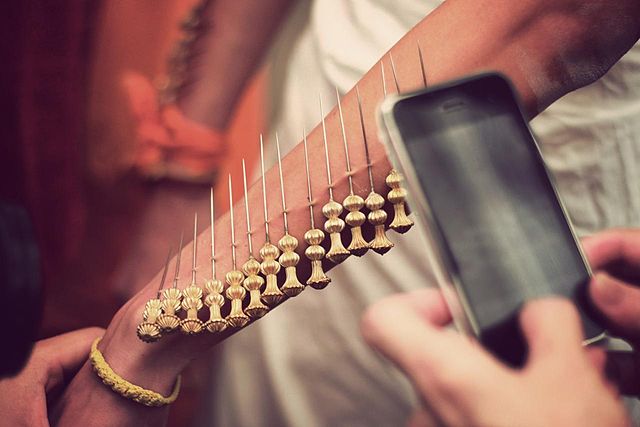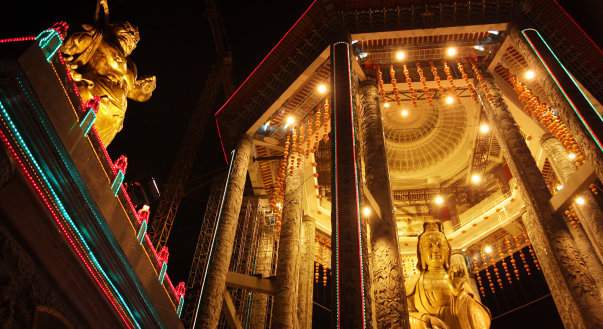The essence of real independent travel is to get to the core of the places we visit: nevertheless, it is a fact that a deeper connection and extra effort may be required for some destinations.
Penang Island, a UNESCO world heritage site floating at the side of Malaysia’s Northwestern coast, is definitely one of these harder places. As I have grown tired of hearing the negative comments of those visitors who barely left the backpacker enclaves of Chulia Street and Love Lane, lamenting that beer is too expensive and locals not friendly, I decided to write a list of useful suggestions to better appreciate the place I currently live, and hopefully turn your couple days stay into a longer, more interesting travel experience.
1. Kek Lok Si Temple and Air Hitam Dam treks
Penang has one of the biggest Buddhist temples in Southeast Asia, Kek Lok Si. Perched on top of a hill overlooking the whole island’s Northeastern coast, it is one of Penang’s most visited locations. I bet you have already been there as your guidebook suggested… but I doubt you decided to venture a couple kilometers further uphill along the main paved road. It is up there that you can find the gorgeous Air Hitam (literally “Black Water”) dam: a massive water basin lying as a volcanic caldera at the very top of the mountain. All around it, a paved road is a great way to get closer to the rainforest for a hike or a healthy run. However, be on the lookout: a bunch of cheeky monkeys may peek at you from the canopy up above, and try to snatch your possessions as they know they may contain food.
2. Balik Pulau’s fishing villages motorbike circuit
Another big mistake in Penang is to arrive at central Chulia Street, settling into a guesthouse, and just spend your time there without leaving this backpackers’ ghetto. In fact, the island has so much more to explore, if you are so inclined. Rent a motorbike at one of the many guesthouses or cafes and venture southwest. Pass through Air Hitam and indulge at suggestion number 1 before continuing southbound towards Balik Pulau, literally a tropical oasis where cars are scarce, palm trees abound everywhere, and you will be able to experience firsthand traditional Malay kampong (village) life. Start by riding up and around the low hills covered in palm estates, from whose trees Penang’s Little India’s mouthwatering dishes get their staple banana leaf trays. Then, head towards the coastline and start exploring a string of small fishing villages where the hustle and bustle of Georgetown will fade away as a lost city memory.
To conclude your day trip, you may spend some time relaxing at one of the deserted pristine beaches, pay a visit to hidden countryside mosques along the way, and finally return to Georgetown via Air Hitam. Or, you may extend your drive up the Northwestern coast and visit the local national park for some great jungle trekking and another tropical dip.
3. Hungry Ghost festival
Try to come to Penang during the seventh month of the Chinese calendar- usually falling in between early and late September- and witness one of the most colorful and entertaining festivals in Southeast Asia. Penang’s original Chinese settlers believed that, during these four weeks, the gates of hell opened to let the King of Hell Tay-su-yeah and his army of “hungry ghosts” unleash among the living. Fear not, as they are not after humans, but come for food, prayers, and some good entertainment.
This is why at this time of the year the Chinese community sets up small shrines cum stages along the streets of Georgetown. Ritual joss sticks are burned, fresh food is offered to the altars, and Chinese opera performers grace the stages with their singing and baroque makeup for the joy of the dead. To add more fun to this happy masquerade, scantily clad beauties perform curious pop-singing shows specifically tailored to please the ghosts’ “visual hunger.” Do not try to sit in the empty front rows, as they are reserved to the dead!!
This carnival ends with a ritual bonfire: witness 5 to 10 meters high paper demons burning in the middle of the streets around Penang state, as the fire brigade stands by in case things go wrong. Now, all the ghosts are happily sent back to keep up the party in the bowels of hell!
4. Thaipusam

Try to time your visit in January to catch this Indian festival, in my opinion one of the most visionary in the whole of Asia, together with the Thailand Vegetarian festival in Phuket. After an auspicious coconut smashing session along the main transport artery Jalan Datò Keramat, you may observe a flock of devotees gathering at Indian temples as they pierce their bodies and faces with hooks and skewers to pay homage to the god of war, Murugan. Follow a 6 kilometers procession as it snakes across the heart of Penang before reaching the most sacred Waterfall Indian temple. As you watch them removing their offerings – kavadi – from aching bodies, you will be carried away by the surreal religious atmosphere. Or, if you are of the squeamish kind, just be happy to enjoy the dances: Bollywood tunes literally explode from giant speakers 24-7, as free food and drinks are dispensed to devotees and visitors alike all along the Sacred Path.
5. Study a forgotten Indian martial art
If you have interest, passion, and most importantly time, you should know that Penang is the last remaining center in the world where you may study Silambam Nillaikalakki, an ancient form of stick fighting originating from Kerala and Tamil Nadu, India. Master Anbanathan is the last remaining in a lineage of Silambam practitioners, and he is eager to teach to people of all ages, nationalities, and religions. Performed four times a week on the rooftop of a multifunctional civic hall tucked away in the suburbia undergrowth of Gelugor, Silambam Nillaikalakki can be practiced for fun or health, and will give your Penang’s stay a unique learning dimension.
6. Enjoy the nightlife
Stop complaining about pricier beer than in neighboring Thailand. Although Malaysia is a predominantly Islamic country, this does not mean that people have nowhere to go to have fun. The places are there, just hidden to the first time visitor and the tourist. Discover the cheap beers at Antarabangsa, a small Chinese run shop tucked away in a corner behind the God of Mercy’s Temple. True, this place is thriving with local drunks, but also artists and street-savvy long term travelers, and it is definitely one of the most characteristics places to drink in Penang.
On the other end of the spectrum, If you fancy some serious headbanging, check out Soundmaker’s shows. Situated in an anonymous building along Pengkalan Weld, just a few hundred meters to the left of the main jetty to Butterworth, this is the place to witness some serious Malaysian – and foreign – musical talent. Mostly focused on the tougher genres of rock and heavy metal, it is not rare to stumble upon the odd DJ set where it is easy – and cheap – to chat up some locals and make some new friends. The possibilities for night fun are many if you know where to go: just get out of Chulia Street and the disco clubs at Little Penang Road.
7. Teluk Bahang national park hikes, camping, and beach hopping
The beauty of Penang lies in its balance of bustling city life and natural landscapes where the jungle is queen. Take bus 101 from Chulia street or the city bus stand at KOMTAR and ride all the way to Teluk Bahang, where the Northwestern corner of Penang still preserves its original tropical beauty. Hike along the coast to Monkey Beach and take a dip in the warm waters before reaching the old lighthouse where you may also camp. You may also take the inland path and cross the jungle to reach Pantai Keracut, where besides camping, you may witness the breeding of baby turtles. Both hiking routes are not demanding and suitable to all inexperienced hikers. Make a pleasant day trip from Georgetown only, if camping is not your pick.
8. Chow Rasta book market

I bet you have not looked too far from Chulia street if you have not found this paradise of old, lost, and rare books. Situated at the top floor of the Chow Rasta meat market, it is right opposite Penang Road’s police station. Dodge the pools of blood and fight the stench as you climb upstairs and find yourself immersed in an ocean of culture: all sorts of books, from old textbooks to travel guides – including some of the rare first editions of Lonely Planet’s titles –can be found here. Be reminded though, you should come only if you have time to spare and a hawk’s eye for detail, as books are literally stacked up to cover every free inch of the tiny cubicle shops. Good luck!! In a country where books are an expensive privilege, Chow Rasta can help you finding some rare, odd gems at cheaper prices.
9 Discover the Chinese Jetties with their houses on stilts
It is disheartening to find out how few Western visitors make it to the historical Chinese jetties, located 10 minutes walk from Chulia street. As the British settlers demanded high land taxes to Penang inhabitants, the cunning Chinese decided to build their houses on stilts, thus avoiding a fee for land use, as they were living above the sea!! These jetties are still beautifully conserved in their wooden glory, and although having been slightly restored, still evoke the old times’ charm. Take an evening stroll to see the sunset from a different perspective and just sit at the edge of one of the jetties to observe life passing by. Or have your dinner at one of the street side stalls lining up the main road facing the sea and kick back for a timeless experience.
Check out hostels in Penang and find a flight to Malaysia
Marco Ferrarese visited more than 45 countries and lived in Italy, the United States, China, Australia and Malaysia. He started vagabonding as a punk rock guitarist in Europe and North America, hitting the most famous and infamous stages across the two continents. Since 2009, he lives in Penang, Malaysia. An expert of the region, is currently a PhD candidate at Monash University, Kuala Lumpur: he is very proud to be researching the anthropology of punk rock and heavy metal in Southeast Asia. He has a weekly column at Rolf Pott’s Vagablogging and blogs about overland travel, lifestyle and alternative music in Asia at monkeyrockworld.com
Photo credits: Goh PS, Nestor’s Blurrylife, nazrimuhi

